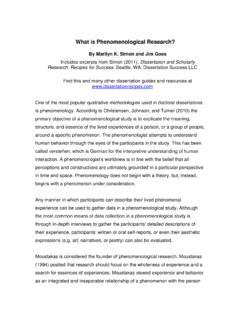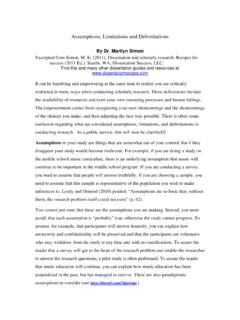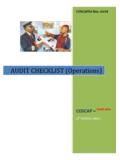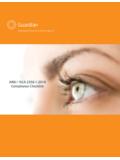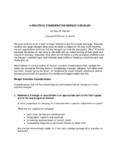Transcription of Purpose Checklist
1 Writing a Purpose Statement Excerpts from: Simon, M. K. (2011). Dissertation and scholarly research: Recipes for success (2011 ed.). Lexington, KY: Dissertation Success, LLC. If we think of the problem statement as the heart of the study, then we can think of the Purpose statement as the brains of the study. The Purpose statement tells your reader what the primary goal of the research is (was). In addition to stating the objective of the research, the Purpose statement informs the reader of: the method of research, population under investigation, the setting, and includes the phenomena or variables being studied. The Purpose statement explains what your study will accomplish. The Purpose statement succinctly creates direction, scope, and the means of data collection. The statement is formulated in a way that assures the reader that the objectives and goals can be obtained, and once these are accomplished, the problem will be solved.
2 A. Purpose statement is usually 1-3 paragraphs. The following Checklist can help you put together a delectable Purpose statement: Purpose Checklist . 1. Key identifier words are used to signal the reader, such as The Purpose of this (qualitative/quantitative/mixed method)/ (methodology) is to The paradigm and methodology need to be appropriate for this 2. The central phenomena being explored are explicated. 3. The variables, if quantitative, are clearly defined. 4. The intent of the study (to analyze, determine, evaluate ) is delineated with words that reflect higher order thinking skills. 5. The participants in the study (sample and/or population) are mentioned. 6. The setting (including geographic location) of the study is explained. 7. Words are well chosen; statements are free from contradiction; the statement is free of jargon, anthropomorphisms, and clich s. No unnecessary words are used.
3 8. The writing has cadence and flows easily; the reader can sense the person behind the words. 9. The Purpose is in accord with and compliments the problem statement. Example 1: The Purpose of this qualitative, descriptive research study is (was) to analyze the personal value patterns and profiles of Generation X and Generation Y managers at an information technology company in the Pacific Northwest. Data were obtained through in depth interviews at locations convenient to the participants. The data were managed with NVivo 8 software. Example 2: The Purpose of the phenomenological study was to investigate individual experiences of African Americans who overcame obstacles and attained the rank of chief within their police organization. According to Feagin and McKinney (2003), work environments of African American officers often involve unfair promotions, lower salaries, excessive discipline, and inefficient training.
4 Results from the current phenomenological study of the human experiences of African American police leaders shed light on obstacles they overcame to achieve success and promotion within law enforcement. The information garnered includes participants' family background and history, educational history, mentorship, socioeconomic status, peer relations, leadership philosophies, and racial and cultural issues. The data collection process incorporated in-depth interviews in an effort to ascertain the experiences that contributed to the participants' successes. Example 3: The Purpose of this quantitative correlational study was to determine the relationship between teacher job satisfaction and the teacher-perceived leadership traits of principals within public schools (K-12) in the coastal region of Virginia. The significance of the relationship is that it may inform an understanding of how teacher leadership influences teacher retention; which has been correlated to satisfaction (Johnson, 2004).
5 The study used validated and reliable attitudinal measures to assess the variables under investigation.



